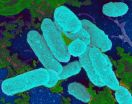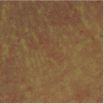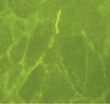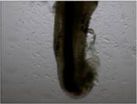(Press-News.org) Cold Spring Harbor, NY – For decades, health-conscious people around the globe have taken antioxidant supplements and eaten foods rich in antioxidants, figuring this was one of the paths to good health and a long life.
Yet clinical trials of antioxidant supplements have repeatedly dashed the hopes of consumers who take them hoping to reduce their cancer risk. Virtually all such trials have failed to show any protective effect against cancer. In fact, in several trials antioxidant supplementation has been linked with increased rates of certain cancers. In one trial, smokers taking extra beta carotene had higher, not lower, rates of lung cancer.
In a brief paper appearing today in The New England Journal of Medicine, David Tuveson, M.D. Ph.D., Cold Spring Harbor Laboratory Professor and Director of Research for the Lustgarten Foundation, and Navdeep S. Chandel, Ph.D., of the Feinberg School of Medicine at Northwestern University, propose why antioxidant supplements might not be working to reduce cancer development, and why they may actually do more harm than good.
Their insights are based on recent advances in the understanding of the system in our cells that establishes a natural balance between oxidizing and anti-oxidizing compounds. These compounds are involved in so-called redox (reduction and oxidation) reactions essential to cellular chemistry.
Oxidants like hydrogen peroxide are essential in small quantities and are manufactured within cells. There is no dispute that oxidants are toxic in large amounts, and cells naturally generate their own anti-oxidants to neutralize them. It has seemed logical to many, therefore, to boost intake of antioxidants to counter the effects of hydrogen peroxide and other similarly toxic "reactive oxygen species," or ROS, as they are called by scientists. All the more because it is known that cancer cells generate higher levels of ROS to help feed their abnormal growth.
Drs. Tuveson and Chandel propose that taking antioxidant pills or eating vast quantities of foods rich in antioxidants may be failing to show a beneficial effect against cancer because they do not act at the critical site in cells where tumor-promoting ROS are produced – at cellular energy factories called mitochondria. Rather, supplements and dietary antioxidants tend to accumulate at scattered distant sites in the cell, "leaving tumor-promoting ROS relatively unperturbed," the researchers say.
Quantities of both ROS and natural antioxidants are higher in cancer cells – the paradoxically higher levels of antioxidants being a natural defense by cancer cells to keep their higher levels of oxidants in check, so growth can continue. In fact, say Tuveson and Chandel, therapies that raise the levels of oxidants in cells may be beneficial, whereas those that act as antioxidants may further stimulate the cancer cells. Interestingly, radiation therapy kills cancer cells by dramatically raising levels of oxidants. The same is true of chemotherapeutic drugs – they kill tumor cells via oxidation.
Paradoxically, then, the authors suggest that "genetic or pharmacologic inhibition of antioxidant proteins" – a concept tested successfully in rodent models of lung and pancreatic cancers -- may be a useful therapeutic approach in humans. The key challenge, they say, is to identify antioxidant proteins and pathways in cells that are used only by cancer cells and not by healthy cells. Impeding antioxidant production in healthy cells will upset the delicate redox balance upon which normal cellular function depends.
The authors propose new research to profile antioxidant pathways in tumor and adjacent normal cells, to identify possible therapeutic targets.
INFORMATION:
"The Promise and Perils of Antioxidants for Cancer Patients" appears in The New England Journal of Medicine on July 10, 2014. The authors are: Navdeep S. Chandel, Ph.D., and David A. Tuveson, M.D., Ph.D. The paper can be obtained at: http://www.nejm.org/
About Cold Spring Harbor Laboratory
Celebrating its 125th Anniversary in 2015, Cold Spring Harbor Laboratory (CSHL) has shaped contemporary biomedical research and education with programs in cancer, neuroscience, plant biology and quantitative biology. CSHL is ranked number one in the world by Thomson Reuters for the impact of its research in molecular biology and genetics, and has been home to eight Nobel Prize winners. Today, CSHL's multidisciplinary scientific community is more than 600 researchers and technicians strong and its Meetings & Courses program hosts more than 12,000 scientists from around the world each year to its Long Island campus and its China center. A 501 (c) (3) not-for-profit organization, CSHL is independently ranked in the top 1% of charities by Charity Navigator. For more information, visit http://www.cshl.edu.
How antioxidants can accelerate cancers, and why they don't protect against them
2014-07-10
ELSE PRESS RELEASES FROM THIS DATE:
Depressed men with prostate cancer are diagnosed later stage, get less effective therapies
2014-07-10
Depressed men with localized prostate cancer were more likely to be diagnosed with more aggressive prostate cancer, received less effective treatments and survived for shorter times than prostate cancer patients who were not depressed, a UCLA study has found.
The negative outcomes may be the result of several factors such as bias against the mentally ill, depression's impact on biological cancer processes, the depressed man's lack of investment in his general health and disinterest in receiving more effective care, and missed opportunities by physicians to educate patients ...
Scientist finds link between antibiotics, bacterial biofilms and chronic infections
2014-07-10
Researchers from the University of Southern California and the Oak Crest Institute of Science have discovered the link between antibiotics and bacterial biofilm formation leading to chronic lung, sinus and ear infections. The study results, published in the current issue of PLOS ONE, illustrate how bacterial biofilms can actually thrive, rather than decrease, when given low doses of antibiotics.
"This research addresses the long standing issues surrounding chronic ear infections and why some children experience repeated ear infections even after antibiotic treatment," ...
BMSCs with Nogo-66 receptor gene silencing for repair of spinal cord injury
2014-07-10
After central nervous system injury, the increase in Nogo protein is mediated by Nogo-66 receptor gene, leading to the collapse of growth cones and inhibiting the extension of neuronal neurites. Zhiyuan Li and his team, Heibei Xingtai People's Hospital, China used RNA interference to silence Nogo-66 receptor gene expression in bone marrow mesenchymal stem cells (BMSCs), blocked the inhibitory effect of Nogo protein, promoted the process growth of neurons differentiated by transplanted cells, improved the therapeutic effects and increased the success rate of BMSCs transplantation ...
Inhibition of NgR expression reduces apoptotic retinal ganglion cells in diabetes
2014-07-10
Activation of Nogo receptor (NgR) is an essential factor of nerve regeneration inhibition, neuronal atrophy and even apoptosis. Upregulation of NgR expression is an important cause of cell apoptosis and visual extinction in some diseases including glaucoma. Whether ganglion cell apoptosis is related to NgR gene expression in diabetes mellitus remains poorly understood. Dr. Xuezheng Liu and his team, Liaoning Medical University, China interfered NgR expression in the retinal ganglion cells of rats with diabetes mellitus and found that Rho kinase expression was obviously ...
Fusion protein of single-chain variable domain fragments and myasthenia gravis
2014-07-10
Single-chain variable domain fragment (scFv) 637 is an antigen-specific scFv of myasthenia gravis and it can bind to acetylcholine receptor in the residues 67-76 of α-subunit of acetylcholine receptor. Dr. Fanping Meng and his team, College of Medicine, Yanbian University in China conjugated scFv and human serum albumin genes and detected the fusion protein in Pichia pastoris. Results showed that the fusion protein bound to acetylcholine receptors in neuromuscular junction of human intercostal muscle and the inhibition rate of fusion protein binding to acetycholine ...
How does miR-21 promote the differentiation of hair follicle-derived NCSCs into SCs?
2014-07-10
Hair follicle-derived neural crest stem cells (NCSCs) can be induced to differentiate into Schwann cells (SCs). However, the underlying regulatory mechanism during cell differentiation remains poorly understood. Dr. Yuxin Ni and her team, Hospital of Stomatology, Jilin University, China isolated NCSCs from human hair follicle and induced them to differentiate into SCs. MicroRNA (miR-21) expression was gradually increased during the differentiation of NCSCs into SCs. After transfection with the miR-21 agonist (agomir-21), the differentiation capacity of NCSCs was increased. ...
The optimal mitomycin C concentration for intact peripheral nerve structure and function
2014-07-10
Recently, local scar adhesion after laminectomy always challenges the worldwide scholars engaged in spine surgery. Mitomycin C, a classical anti-tumor drug, has been attempted to be used to effectively inhibit scar adhesion after laminectomy and some encouraging outcomes have been achieved. However, there is evidence that mitomycin C has inherent toxicity and other side effects when it is locally used. Whether mitomycin C can influence peripheral nerve structure and function remains unclear. Dr. Tao Sui and his team, the First Affiliated Hospital of Nanjing Medical University, ...
New research: Fresh avocado enhances absorption of essential nutrients for healthy living
2014-07-10
IRVINE, Calif. (July 10, 2014) – Consuming a whole fresh avocado with either an orange-colored tomato sauce or raw carrots significantly enhanced provitamin A carotenoid (alpha- and beta-carotene) absorption and conversion of these carotenoids to an active form of vitamin A, according to new research (1) published in The Journal of Nutrition.
Vitamin A is involved in reproductive health and growth promotion; helps support healthy skin, immune function, and vision; and has antioxidant properties. Provitamin A carotenoids, like alpha- and beta-carotene, impart the orange ...
Invasion of yellow crazy ant in a Seychelles UNESCO palm forest: Threats and solutions
2014-07-10
The yellow crazy ant Anoplolepis gracilipes is ranked amongst the top 100 worst global invasive species and is responsible for catastrophic ecological impacts on islands. A new study published in the open access journal NeoBiota examines and assesses the effects and dangers of the introduction of the yellow crazy ant to the unique,endemic ecosystem of the mature palm forest of the Vallée de Mai, a UNESCO World Heritage Site, on the Seychelles.
The palm forest of Vallée de Mai is a unique ecosystem containing many endemic species, including the iconic coco de mer palm ...
New diagnostic test to distinguish psoriasis from eczema
2014-07-10
In some patients, the chronic inflammatory skin diseases psoriasis* and eczema** are similar in appearance. Up to now, dermatologists have therefore had to base their decision on which treatment should be selected on their own experience and an examination of tissue samples. A team of researchers at the Helmholtz Zentrum München and the Technical University of Munich (TUM) have now analyzed the molecular processes that occur in both diseases and discovered crucial differences. This has enabled them for the first time to gain a detailed understanding of the ways in which ...








